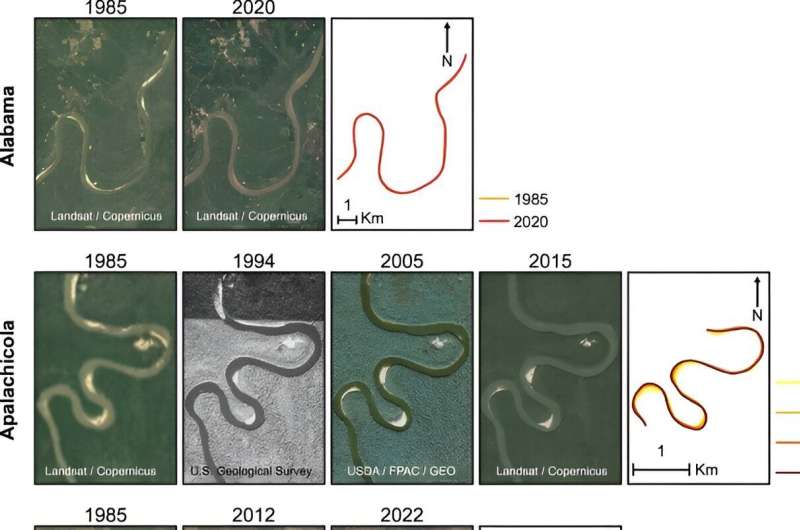This article has been reviewed according to Science X's editorial process and policies. Editors have highlighted the following attributes while ensuring the content's credibility:
fact-checked
peer-reviewed publication
trusted source
proofread
Study examines Earth and Mars to determine how climate change affects the paths of rivers

In a new study published in Nature Geosciences, researchers, led by a Tulane University sedimentologist , investigated why the paths of meandering rivers change over time and how they could be affected by climate change.
Chenliang Wu, Ph.D., a postdoctoral researcher at Tulane University School of Science and Engineering, began this research by looking at the Mississippi River before adding other rivers on Earth and ancient riverbeds on Mars to the study.
The study specifically looks at river sinuosity, or how much rivers curve. The sinuosity of rivers changes over time, depending on the age of the river and environmental changes. Some of these changes include sediment and water supply and riverbank vegetation, all of which are affected by climate change.
The study found that river sinuosity is related to the changes in how much water flows through the river. Rivers have different water levels depending on environmental factors, like precipitation levels.
The researchers looked at maps of the rivers on Earth over time by using historical data from as early as the fifth century and images from as early as 1939. They used data of 21 lowland meandering rivers. For the ancient riverbeds on Mars, they used previously identified ancient river channels from remote sensing data.
The ancient riverbeds on Mars, untouched by human influence, gave Wu and his team a system to test their hypotheses on how the river systems migrated and what their sinuosity looked like by the time they dried up. Their analysis is also a step toward understanding what the hydroclimate on Mars was like when there was still surface water.
"It really lays the foundation for more advanced topics," Wu said, "like, were the environmental conditions suitable for life on Mars?"
After performing analysis on the rivers, the researchers separated them into two categories: variable-sinuosity and constant-sinuosity. The variable-sinuosity rivers never reached a steady state, meaning their sinuosities continue changing, and the constant sinuosity rivers did reach a steady state, meaning their average sinuosity remained relatively constant. Of the 21 Earth rivers studied, 13, including the Mississippi River, had variable sinuosity, while eight had constant sinuosity.
Understanding what factors affect the sinuosity of rivers will give researchers and engineers insight into how to manage rivers in the future. It can help with river restoration, future infrastructure projects and flood management. This insight can be invaluable in attempts to mitigate the impacts of climate change.
As more extreme weather happens more frequently due to the effects of climate change, research like Wu's will become even more important when it comes to protecting and helping populations who live near rivers. According to a 2019 study in the International Journal of Water Resources Development, half of the world's population lives in river basins, all of whom could be affected by future floods from extreme weather events.
More information: Chenliang Wu et al, Lowland river sinuosity on Earth and Mars set by the pace of meandering and avulsion, Nature Geoscience (2023). DOI: 10.1038/s41561-023-01231-1
Journal information: Nature Geoscience
Provided by Tulane University




















